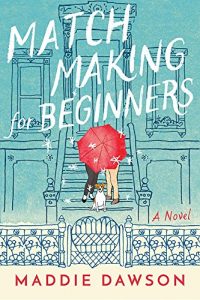The Book in the Drawer, or Writing About Your Family Members
 I started my first novel by accident. I was on the phone with my mother at the time—and to keep myself sane while I talked to her, I idly started typing what she was saying in her animated, breathy, giddy voice.
I started my first novel by accident. I was on the phone with my mother at the time—and to keep myself sane while I talked to her, I idly started typing what she was saying in her animated, breathy, giddy voice.
She had just that day decided to get married again! To a man she had known for two weeks! A really handsome man! With a nice pension! He might be the love of her life, showing up at this late date! “Husband number three, but who’s counting?” she said. “And don’t tell me that this is crazy because I’ve decided that I’m going to live my life the way I want to!”
She might have been a little psychiatrically interesting, my mom.
So I typed the sentence: “My mother has decided to get married again, this time to a man she has known for two weeks,” and after we hung up an hour later, during which I learned I would not be invited to the wedding nor were his kids invited, I just kept typing. And a character started taking shape in the pages that came out with a rush: the first-person story of a young, newly divorced woman trying to cope with the fallout from being raised by a wild itinerant fortune-teller who has no boundaries or stability. The mom in the book is larger than life, hilarious. exuberant, bi-polar, taking on husbands and life situations (and her daughter’s high school boyfriend) without looking at the damage she leaves in her wake. The daughter learns that she can’t change her mother.
It was entirely fictionalized, but it was my mom.
Seventeen years after the evening when that initial sentence was written, the book was published by Shaye Areheart Books under the title, What Comes After Crazy. It had been rewritten hundreds of times by that point. Characters morphed and grew and changed; some left the book altogether when their services were found unnecessary. As technology changed, so did my characters’ needs. First they had to get answering machines and then computers and cell phones.
For several years, the manuscript lived in a drawer, only to be rediscovered during cleaning binges, when I’d take it out and start working on it, feverishly, between carpool runs, or while I watched field hockey practices. It went along in a suitcase on all our family vacations. My three children grew up seeing me typing first on an old Selectric; then when that died, on an electric typewriter I bought one summer at the Cape; then on an early Compaq; later, on a ten-pound laptop I lugged into coffee shops. With the money I made on the advance, I bought a Mac.
When the novel was accepted, Shaye Areheart (my wonderful publisher) took me to The Plaza in New York for tea to celebrate. While we were admiring the tower of petit fours and sipping tea in china cups, she said to me, “So is this book about your mother, but just amped up a bit?”
I put down my cup carefully into the saucer. It wobbled a little. “Actually,” I said, “it’s my mother but toned down a bit.”
The funny thing was, I had been okay with the book remaining in the drawer for all those years, never seeing the light of day. I’d been worried about my mother’s reaction. I didn’t want to hurt her, and yet I was compelled to keep writing the story. I didn’t seem able to let it go.
But then something changed.
My mother paid us a visit up north. She rarely left Florida, but there she was in our Connecticut house—unpacking her suitcase and announcing she was staying for a week.
And she insisted on reading the manuscript. “Come on, I can take it,” she said, smiling. “I know that parts of it must be about me. I really don’t mind.”
I finally relented, but I had a stomachache for the entire day when she took it to the family room and closed the door and read it. Hours and hours passed. I practiced how I would react when she threw all the pages at me and stormed off in a huff, back to Florida.
Just before dinner, she emerged. We stood looking at each other. I was holding a wooden spoon. She was holding the pages of the book.
“Wow,” she said at last. “You really nailed your grandmother!”
Anne Lamott once said that people won’t recognize themselves in your work if you give their character some unfortunate characteristics—a tiny penis for a man, for instance. And maybe that’s really true. I had changed the hair color of the mother character from blonde to black, had her be a little bit overweight, and perhaps that’s all I needed to do to disguise her.
Now it’s years later—and my seventh novel, Matchmaking for Beginners, was just published. It’s about a young woman who inherits a house in Brooklyn from an older woman who lives an unconventional life casting spells and helping people find love in the unlikeliest places. My mom isn’t in this one, yet even I realize that her spirit infuses every older woman character I write. Now that she’s been gone for eleven years, I see her more realistically now. When she shows up in my work these days, she’s a fraction of her former self—more a mixture of a free-spirit character who believes in magic, who has a sense of adventure and curiosity, who loves to laugh and dance, who throws off convention for the uncharted path.
I had several years of therapy to help me deal with the legacy of my mom, and I did learn how to accept the things about her that I couldn’t change, and to love the things about her that were true gifts to me.
But it’s when I’m at my writing desk, writing fictional characters who show up and tell me their stories, that I feel how lucky I am to have this path toward understanding. It’s through writing that I make sense of what my life has been about.
My work is fiction, and the stuff that happens in my novels didn’t happen in real life…but the stories are the truth.
—
Maddie Dawson, the pen name of writer, Sandi Kahn Shelton, is the author of seven novels and three non-fiction humor books about parenting. Her latest book, Matchmaking for Beginners, is a Washington Post and Amazon bestseller–and when she’s not out doing cartwheels over that happy news, she’s at work writing a sequel. She teaches creative writing in the Words at Play writing workshop, and has three grown kids who are so glad she’s not writing about parenting anymore. She lives in Guilford with her husband.
MATCHMAKING FOR BEGINNERS, Maddie Dawson
 Marnie MacGraw wants an ordinary life—a husband, kids, and a minivan in the suburbs. Now that she’s marrying the man of her dreams, she’s sure this is the life she’ll get. Then Marnie meets Blix Holliday, her fiancé’s irascible matchmaking great-aunt who’s dying, and everything changes—just as Blix told her it would.
Marnie MacGraw wants an ordinary life—a husband, kids, and a minivan in the suburbs. Now that she’s marrying the man of her dreams, she’s sure this is the life she’ll get. Then Marnie meets Blix Holliday, her fiancé’s irascible matchmaking great-aunt who’s dying, and everything changes—just as Blix told her it would.
When her marriage ends after two miserable weeks, Marnie is understandably shocked. She’s even more astonished to find that she’s inherited Blix’s Brooklyn brownstone along with all of Blix’s unfinished “projects”: the heartbroken, oddball friends and neighbors running from happiness. Marnie doesn’t believe she’s anything special, but Blix somehow knew she was the perfect person to follow in her matchmaker footsteps.
And Blix was also right about some things Marnie must learn the hard way: love is hard to recognize, and the ones who push love away often are the ones who need it most.
RT Book Reviews (4 ½ Stars – Top Rated) Infused with the kind of magic so frequently lost as we become adults, this one-of-a-kind novel pushes the boundaries of coincidence and connection by asking us to believe in fate and, possibly, magic once again.
BUY THE BOOK HERE
Category: Contemporary Women Writers, How To and Tips
























This is a wonderful article, and I appreciate your taking the “character” that your mother was and running with it (in different directions, at different paces.) I laughed out loud when your mother proclaimed,”You really nailed your grandmother!” I have a bi-polar sister who had to be included in the book I’ve just finished (My Dad My Dog, fictional but based on real-life family dynamics and dementia.) It was a really challenging to make her not her. I kept imagining her reading the book and having one of her “fits,” so I made her thin and beautiful. Since she’s also a narcissist, I’m hoping she’ll focus on that : )
Change the hair color and add a few pounds, eh? Sounds like a plan…
Hey Maddie,
I really enjoyed your story about how you started writing your book about your mom! In similar ways, you were writing about my mom, as she was also a bit bipolar, crazy and unaware of the damage she inflicted. She is gone now and has been gone for a long time, yet the legacy lives on.
I just finished my autobiography and of course, she is in it, and like you said, writing this book his given me perspective of what my early home life with mom was like and how it shaped me into who I am today! I also underwent several years of therapy, yet feel those years helped me sort out a lot and emerge with a better outlook on life. Although I didn’t have any manuscript hidden in any drawers, I did find numerous journals lying around the house and after years painstakingly tedious review of the journals, I turned it into a book!
I am wondering if you went through a traditional publisher, or self-published?
Thanks so much for your interesting and thought-provoking article! Look forward to your reply! Best wishes and Write On!!!